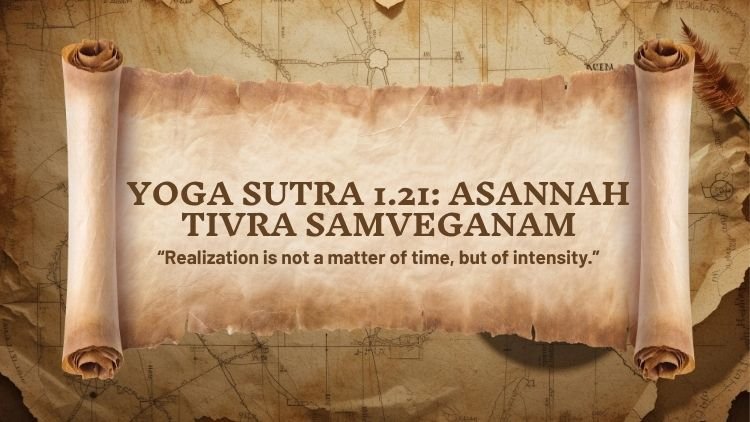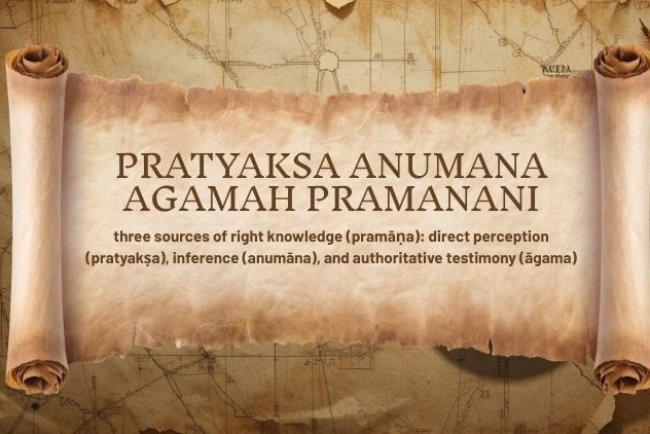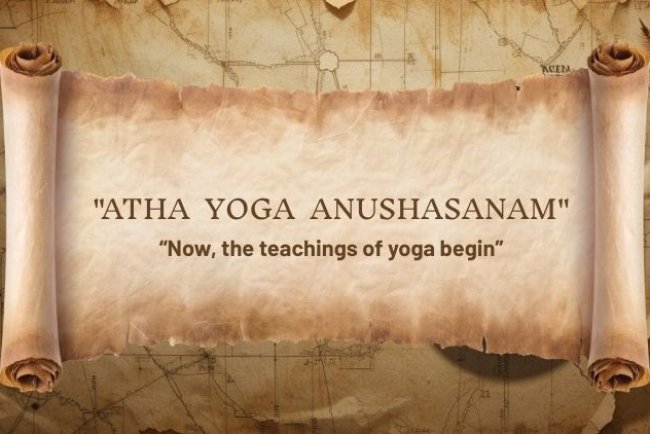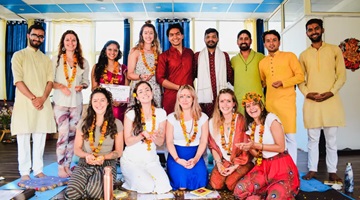Yoga Sutra 1.21: Asannah Tivra Samveganam

“Realization is not a matter of time, but of intensity.”
The Yoga Sutras of Patanjali offer a profound and systematic path toward liberation for sincere seekers. Each sutra builds upon the previous one, weaving together practical guidance and deep philosophical insight.
In Sutra 1.21: Asannah Tivra-Samveganam, Patanjali emphasizes a powerful truth: the intensity of one’s aspiration and effort determines how quickly one attains realization. This follows naturally from the previous sutra (1.20), which outlines the essential qualities for progress on the yogic path — faith (sraddha), energy (virya), memory (smrti), meditation (samadhi), and wisdom (prajna).
Though expressed in simple words, this sutra carries immense depth. It reminds us that true yoga is not bound by the passage of time but by the depth of our sincerity and the fire of our purpose. The closer we are to our inner intensity, the nearer we come to self-realization.
The Sutra in Sanskrit and Translation
Sanskrit: तीव्रसंवेगानामासन्नः ॥२१॥
Transliteration: Tivra-samveganam Asannah
Translation: “For those whose practice is intense and wholehearted, the goal is near.”
Word-by-Word Meaning
-
Tivra (तीव्र): Intense, sharp, ardent — symbolizing the burning enthusiasm and inner fire that fuels transformation.
-
Saṁvega (संवेग): Spiritual urgency, deep resolve, or the passionate drive to transcend limitations.
-
Asannah (आसन्नः): Near, imminent, or likely to be attained.
Full Meaning
This sutra conveys that those who approach their yogic journey with profound sincerity and passionate intensity progress rapidly toward realization.
It is not the length of practice that matters most, but the depth of one’s devotion and the strength of one’s determination.
What Does This Sutra Mean?
This sutra reminds us that spiritual freedom is not measured by the hours we spend on the mat, but by the depth of our dedication and the purity of our intention.
Two individuals may devote the same amount of time to yoga, yet their results can differ vastly. The difference lies in how they practice:
-
One may approach yoga casually, moving through the motions without true presence — progress will come, but slowly.
-
The other may practice with heartfelt passion, focus, and persistence — and for them, the journey toward realization becomes much shorter.
Patanjali here reveals a timeless truth that extends far beyond yoga: in every aspect of life, intensity and sincerity accelerate growth. When practice is infused with urgency, devotion, and longing for truth, the goal draws near effortlessly.
The Role of Samvega (Spiritual Urgency)
The word Samvega holds deep significance. It is not mere excitement or enthusiasm — it is a sacred urgency, a wake-up call from within. It is the realization that life is fleeting, fragile, and unpredictable — and that true freedom cannot wait.
Saṁvega is the inner flame that whispers —
“I must awaken now.
Not tomorrow. Not someday. Now.”
This urgency does not arise from fear, but from wisdom — the understanding that worldly pursuits like wealth, fame, or transient emotions can never satisfy the soul. From this insight emerges Mumuksutva, the deep longing for liberation.
The Three Levels of Intensity
Patanjali describes practitioners according to the range of their spiritual intensity (Saṁvega):
-
Low Intensity (Manda-Samvega):
Practice is irregular or half-hearted. Progress is slow, and transformation unfolds gradually over time.
-
Moderate Intensity (Madhya-Samvega):
Practice is steady and consistent, yet lacks the burning desire for awakening. Results appear, but in proportion to life’s circumstances and distractions.
-
High Intensity (Tivra-Samvega):
Practice is continuous, focused, and fueled by an unshakable longing for truth. Liberation feels near — not because there’s a shortcut, but because all distractions begin to dissolve.
Patanjali highlights this third path — the way of intensity — as the key to swift spiritual realization. It is through unwavering devotion, clarity, and effort that the seeker transcends time and draws close to freedom.
Application in Contemporary Life
Many practitioners wonder: How can one live with tivra-samvega — deep spiritual intensity — amid the rush of modern life, work, and family responsibilities?
The answer lies not in escaping the world or retreating to the Himalayas, but in cultivating depth of inner involvement in everything you do.
-
Intensity over duration: Even brief moments of sincere, focused practice each day carry more power than hours of distracted effort.
-
Mindfulness of impermanence: Remember that life is fleeting — this awareness brings urgency without anxiety.
-
Wholehearted engagement: Whatever time you have, give it your full presence and commitment. That sincerity is what transforms practice into progress.
Intensity: The Pulse of Yoga
Yoga is not merely a physical discipline; it is a path of total inner transformation. Intensity plays a vital role because it:
-
Burns away lethargy and inertia (tamas).
-
Shields the mind from worldly distractions and desires.
-
Sharpens focus and deepens purpose.
-
Accelerates the dissolution of karmic impressions (samskaras).
Just as fire blazes brighter with greater heat, so too does the practice of yoga burn through ignorance more swiftly when fueled by devotion and zeal.
Balancing Intensity and Sustainability
While intensity is essential on the spiritual path, it must be harmonized with sustainability. The yogic journey is systematic and gradual, not driven by compulsion or restlessness. True intensity arises from dedication, not from force.
-
Healthy intensity: Rooted in wisdom, patience, and self-compassion.
-
Unhealthy intensity: Driven by comparison, ambition, or disregard for one’s physical and mental well-being.
Patanjali points toward the first — a steady, luminous enthusiasm born from a sincere longing for liberation.
Comparative Insight
This truth is not unique to yoga; it echoes through the great spiritual traditions of the world:
-
The Buddha taught appamada — constant mindfulness and alert diligence in practice.
-
The Bhagavad Gita reminds us: “With devotion, effort, and one-pointed focus, Arjuna, one attains the Supreme.”
-
Zen (Mahayana) Buddhism speaks of cultivating Great Doubt and Great Determination — the forces that lead to awakening.
All these teachings converge on one timeless message:
Half-hearted practice leads to half-hearted results.
Intensity of purpose is the key that swiftly unlocks the door to truth.
Practical Ways to Cultivate Tivra Samvega
-
Contemplate impermanence: Reflect on the transience of life to awaken inner urgency.
-
Clarify your intention: Revisit why you practice — for freedom, peace, and self-realization.
-
Simplify your life: Reduce distractions to conserve energy for spiritual growth.
-
Stay close to inspiration: Read sacred texts, learn from teachers, or meditate with your sangha (spiritual community).
-
Self-inquiry: Ask yourself often — “Am I practicing wholeheartedly, or merely out of habit?”
Final Thoughts
Yoga Sutra 1.21 serves as a profound reminder that realization is not a matter of time, but of intensity. Freedom is not reserved for a chosen few — it is available to all who walk the path with burning sincerity, devotion, and unwavering commitment.
Patanjali does not dismiss gradual progress, but he offers a timeless truth:
The more earnestly one longs for liberation and aligns every action with that longing, the swifter the journey becomes.
In a world filled with distraction and delay, this sutra calls us to authenticity and presence. It invites us to awaken now — to bring energy, mindfulness, and focused intention into every breath and every act.
For the seeker who practices with wholeheartedness, freedom is not distant — it is Asannah, near at hand.
What's Your Reaction?


























